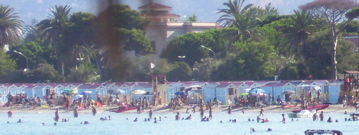Travels with Lois and Jason
Portugal, Spain and
Italy
August
9
- 30, 2008
This was two different vacations rolled into one. From August
9th to 23rd we cruised the Atlantic and Mediterranean. We
spent the 23rd to 30th in splendor in Sicily with our three
granddaughters (and their parents) who live in Israel. The
week with the kids was spent swimming at the pool, playing at the
beach, and eating, and was wonderful. We see them too
infrequently, but when we’re together, its great. It was a
fabulous way to end one of the most educational cruises we’ve taken.
Our cruise was officially titled Voyage to the Mediterranean, with
the subtitle of Moorish and Christian Influences on
Architecture. We selected this particular cruise for two
reasons: it was visiting ports we never heard of before, and
we really liked the cruise company, Swan Hellenic, with their
emphasis on educational cruising with an all inclusive cost
structure. We were not disappointed.
Our travel adventures the past few years have focused on scenery and
natural beauty. This adventure was a feast for the mind,
bringing ancient history into sharp focus, and delighting our senses
with man-made structures and accomplishments. There were
three truly amazing highlights of the trip: Our introduction
to Henry the Navigator in Portugal (Portimao), the Alhambra Palace
in Spain (Malaga), and the Ostia ruins in Italy (Civitavecchia).
 The map shows the route of our cruise. We flew
to London on August 7 (our 42nd anniversary day), arriving at
Heathrow on the 8th. We embarked on the 9th from Dover, around
4:00 PM in stormy weather.
The map shows the route of our cruise. We flew
to London on August 7 (our 42nd anniversary day), arriving at
Heathrow on the 8th. We embarked on the 9th from Dover, around
4:00 PM in stormy weather.
Our first port of call was to be St. Peter Port, Guernsey, one of
the channel islands between England and France. The ship's
tenders were to be used to take us ashore, but when we arrived on
the 10th, the seas were so rough that it was decided that walking
the gangway to the tenders would be tantamount to walking the plank
on a pirate ship, and so we moved on without dropping anchor and
spent the day dealing with rough seas and huge swells crossing
Biscay Bay (that large crescent shape formed by France on the north
and Spain on the south). The captain gave a talk later in the
cruise encouraging everyone to go to Antarctica, and said that our
two days crossing Biscay Bay was no worse than sailing the Drake
Passage! (See our Antarctica
adventure
for details.)
Our time at sea was spent attending outstanding lectures focused on
the history, culture, and architecture of our ports of call.
There was so much new information it wasn't until toward the end of
the cruise that many of the names and events began to fit
together. One of the lectures discussed "The Grand Tour," that
educational journey taken by well-to-do young Englishmen at the end
of their formal educational, at about age 18 - 20, during the 17th
and 18th centuries, to round out their knowledge and give them a
sense of the world. We felt like we were on our own "Grand
Tour" with basically the same goals. We made our first landing
at Oporto, Portugal, on Tuesday, August 12th.
12 Aug Oporto, Portugal (port Leixoes)
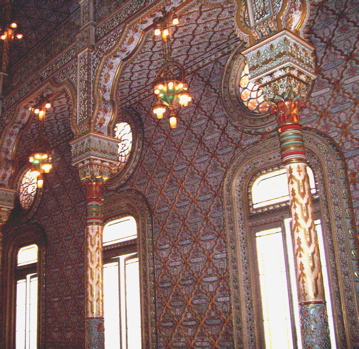 Oporto
is known for its port wines, and we visited a winery for a
tasting. We had our first taste of exotic Moorish architecture
while visiting the Palácio
da Bolsa (Classical Stock Exchange).
The tour took us from room to room, pointing out the beautiful
inlaid wood work, geometric patterns and different exotic woods
(some naturally red in color, others black) from Africa and the New
World to demonstrate the wealth accumulated by Portugal at that
time. Then we went into the The Arabian Room and were blown
away by the colors and intricate designs as shown in Lois' picture
at right. Click here for Internet view of the entire Arabian
Room. For several hundred years, Jews, Moors and
Christians peacefully co-existed throughout the Iberian Peninsula,
in both Spain and Portugal, and they each played an important role
in the commerce of the area.
Oporto
is known for its port wines, and we visited a winery for a
tasting. We had our first taste of exotic Moorish architecture
while visiting the Palácio
da Bolsa (Classical Stock Exchange).
The tour took us from room to room, pointing out the beautiful
inlaid wood work, geometric patterns and different exotic woods
(some naturally red in color, others black) from Africa and the New
World to demonstrate the wealth accumulated by Portugal at that
time. Then we went into the The Arabian Room and were blown
away by the colors and intricate designs as shown in Lois' picture
at right. Click here for Internet view of the entire Arabian
Room. For several hundred years, Jews, Moors and
Christians peacefully co-existed throughout the Iberian Peninsula,
in both Spain and Portugal, and they each played an important role
in the commerce of the area.
13 Aug Lisbon, Portugal
The highlight of this port was the Tile Museum where we learned how
tiles were made. There was one panel that went around the
entire room depicting the history of Lisbon in 1700, before the
great earthquake of 1755 that completely destroyed the city.
Since Portugal had no artists, the tiles were made by the Dutch and
are called Delft tiles (named after the city where they were made)
and are all blue and white. As we drove around Lisbon we
noticed decorative tile works on homes and buildings
everywhere. This exterior decorative use illustrated a
major difference between European and Moorish architectural
styles of the time. The Moors made the outside of their
buildings plain, but their lavish interiors would take your breath
away. The Europeans on the other hand, made extensive use of
decorative exteriors and embellished both inside and outside of
churches and buildings.
14 Aug Portimao, Algarve, Portugal

We spent the morning walking around town and the beach area (and
purchased tee-shirts), and then the afternoon tour took us to the
lighthouse on Cape St. Vincent -- the western most point of the
European continent (and historically referred to as the "end of the
earth"). We next went to the fortress build by Henry the
Navigator, who, as legend has it, created the scientific center of
his time (circa 1420). Scholars and scientists of the early
15th century were brought together to study astronomy, map making
and seafaring navigation, and laid the foundation for and invented
many of the tools used by the explorers in their great voyages of
discovery, with of course, that of Columbus the most famous.
We marveled at the great compass (or is it a clock), which was
state-of-the-art at its time.
5 Aug Cadiz, Spain
Today was Sherry wine tasting in Jerez, a small town west of Cadiz
itself.
16 Aug Granada, Spain (port Malaga)

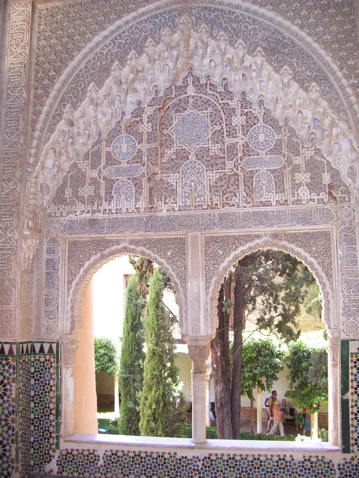 We
took a two hour drive through the foothills to the base of the
Sierra Nevada, into the region known as Granada, and up to the
Alhambra Palace. As we drove the landscape looked very much
like Southern Cal, with hillsides of brown dried out grasses and a
smattering of trees. Our road transversed a major
agricultural area, with olive and avocado groves. We saw only
minimal livestock. We went through the city of Granada, and
then up a steep windy road to reach the Alhambra, where we were
transported back in time to buildings out of the Arabian
Nights. The Alhambra was a palace and fortress complex of the
Moorish rulers of Granada in southern Spain, dating from around
1235. When Ferdinand and Isabella conquered the Moors in 1492,
they wanted to make the Alhambra their capital given that it was
considered one of the most beautiful buildings in all of
Spain. But after their deaths in the early 1500's the capital
moved to Madrid and the Alhambra went into disrepair. It was
the American writer Washington Irving, whose travel guide Tales of the Alhambra, first
published in 1850, brought this incredible architectural gem to the
attention of the world. The Alhambra is considered one of the
greatest accomplishments of Islamic art and architecture. The
horseshoe archways, the intricate and rich designs, the quiet
fountains and lovely gardens were truly
awesome. We saw the remnants of colored
tiles, decorative motifs including arcades, pools, fountains in a
spectacular garden, and inner courtyards, vistas and rooms with
intricate niches, ceilings and vaults. We were told that the
Arabian Room at the Oporto Stock Exchange was illustrative of what
the interior of the entire Alhambra would have been. We ended
our visit seeking out a gift shop to purchase both a copy of
Washington Irving's Tales
and tee-shirts.
We
took a two hour drive through the foothills to the base of the
Sierra Nevada, into the region known as Granada, and up to the
Alhambra Palace. As we drove the landscape looked very much
like Southern Cal, with hillsides of brown dried out grasses and a
smattering of trees. Our road transversed a major
agricultural area, with olive and avocado groves. We saw only
minimal livestock. We went through the city of Granada, and
then up a steep windy road to reach the Alhambra, where we were
transported back in time to buildings out of the Arabian
Nights. The Alhambra was a palace and fortress complex of the
Moorish rulers of Granada in southern Spain, dating from around
1235. When Ferdinand and Isabella conquered the Moors in 1492,
they wanted to make the Alhambra their capital given that it was
considered one of the most beautiful buildings in all of
Spain. But after their deaths in the early 1500's the capital
moved to Madrid and the Alhambra went into disrepair. It was
the American writer Washington Irving, whose travel guide Tales of the Alhambra, first
published in 1850, brought this incredible architectural gem to the
attention of the world. The Alhambra is considered one of the
greatest accomplishments of Islamic art and architecture. The
horseshoe archways, the intricate and rich designs, the quiet
fountains and lovely gardens were truly
awesome. We saw the remnants of colored
tiles, decorative motifs including arcades, pools, fountains in a
spectacular garden, and inner courtyards, vistas and rooms with
intricate niches, ceilings and vaults. We were told that the
Arabian Room at the Oporto Stock Exchange was illustrative of what
the interior of the entire Alhambra would have been. We ended
our visit seeking out a gift shop to purchase both a copy of
Washington Irving's Tales
and tee-shirts.
17 and 18 Aug Cruising the Mediterranean
Sea
Excellent lectures on antiquities, culture and art of the ancient
world. The lectures on daily life of Roman citizens set the
stage for our visit to Ostia (Port of
Rome) where the lectures really came to
life. Speaker after speaker, and the various tour guides in
different cities, explained that when the Roman's conquered a
territory, they would adopt and incorporate all that they could from
that culture rather than simply destroy it. There were also a
couple of talks on the history of Sicily. For centuries Sicily
was known as the "breadbasket" of the known world, and that combined
with its strategic location, made for lots of wars and changing
rulers. Our speakers focused on the Norman kings who ruled for
most of the 11th century and built the incredible church, Monreale
Cathedral, that we were to visit in a few days.
19 Aug Sardinia, Italy (port Cagliari)
For our short visit, the name Sardinia was more mystical than the
place itself. The city tour took us to the old city walls and
some nice view points, but not much to write home about. We
saw lots of flamingos in the salt flats as our bus whizzed by.
20 Aug Civitavecchia (Port of Rome), Italy
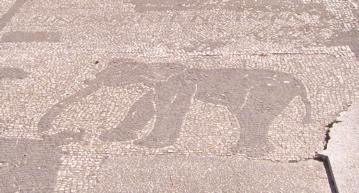
We took a morning tour to Ostia, at the mouth of the River
Tiber. Our guide was among the top we have ever had on any
trip anywhere. Not only did she bring the ruins to life, she
helped us tie so much of the history of the ancient world
together. Ostia was founded by the Romans in the 4th century
BCE. This city which thrived for almost 800 years was the Port
of Rome, the commercial gateway – the world trade center –
through which all ocean based trade with the entire known world
flowed. Merchants used mosaics to advertise their wares,
whether it was elephants from Africa, grapes from the north, or
local ship builders. Eventually the river shifted course, leaving
the city “high-and-dry” (in other words, making the city obsolete),
and thus abandoned. The ruins now give a good impression of
everyday life in a working Roman town. The ruins of the shops,
homes,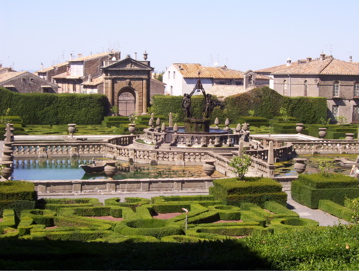 trading houses with their beautiful mosaics, are
well preserved, as are the sewer and fresh water canals. The
Roman government’s position was at the time to provide free food and
entertainment to keep the populace happy and content (i.e.,
preventing uprisings and rioting).
trading houses with their beautiful mosaics, are
well preserved, as are the sewer and fresh water canals. The
Roman government’s position was at the time to provide free food and
entertainment to keep the populace happy and content (i.e.,
preventing uprisings and rioting).
Our afternoon was a visit to the Villa Lante di Bagnaia gardens,
constructed during the 16th century and listed as Italy's most
impressive examples of a Renaissance art garden. The goal of
the garden planners was to create a certain mood and demonstrate
man's control of nature. The garden was on four levels, with
water as a central theme throughout. The upper garden was to
represent nature in its "wild form" and the fountain (which was
unfortunately dry) was supposed to represent flooding, while the
lowest garden, pictured right, is total serenity, manicured and
calm. Everything was laid out symmetrically, again to
emphasize man's ability to control. It was lovely!
21 Aug Sorrento, Italy
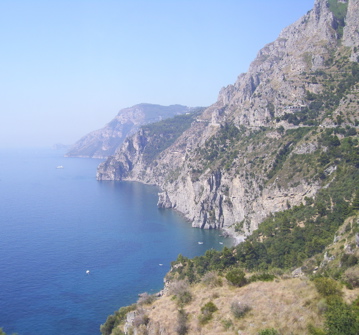
Our ship dropped anchor in the Bay of Naples by the town of
Sorrento, which is perched atop the cliffs overlooking the
sea. We took the ship's tender to the docks and had planned to
take a public bus to Amalfi, a town a couple of hours south along
the very scenic Amalfi Drive, a narrow coastal road that connects
Sorrento and Amalfi. The road is built along steep bluffs and
is one hairpin turn after another, and houses and hotels are built
into the rocks. From Amalfi we were going to take a hydrofoil
back to Sorrento. But half way down the drive (about an hour
drive) we had to get off the bus at Positano as a landslide had
closed the road a few miles ahead. So, we got back on the bus
going the other way and enjoyed the spectacular views on the return
ride. The ride to Positano was gorgeous.
22 Aug Palermo, Sicily, Italy
Our Palermo tour was interesting as we were shown more opera houses
and theaters than churches, not that the churches weren't there and
plentiful, just not as dominant. At one point we were shown a
street sign written in Greek, Arabic and Hebrew as that was the
Jewish quarter and the sign was to commemorate
the contribution of the Jewish community to Palermo. Our tour took
us up to the mountains surrounding the city to the Monreale
Cathedral, a church built by the Norman kings, blending both Norman
(thick fortress like walls) and Arab (intricate and delicate
interior designs) architecture. Every square inch of the
interior was covered with some form of artwork, mosaics, statues,
and all with gold leaf. The Cathedral's interior is considered
one of the most ornate (and expensive) in all of Europe as two tons
of gold was used on its walls and ceiling. And the cloisters
where equally beautiful, with every column decorated and with an
artistic rendering of stories from the Bible on each of it's
capital. Our tour ended at the Mondello Beach Resort where we
had high tea. We were fascinated by the changing room which
people rent all along the beach area.
23 - 30 Aug Club Med Kamarina, Sicily
Spent the week swimming each morning at the children's pool and
building sandcastles on the beach in the afternoon. What a
treat to spend an enjoyable week with the grand-kids, and a great
way to end our vacation.
Photo journalist: Lois Frand
Writer:
Jason Frand
Editor:
Lois Frand
You can
reach us via email at Jason
or Lois
September
13,
2008

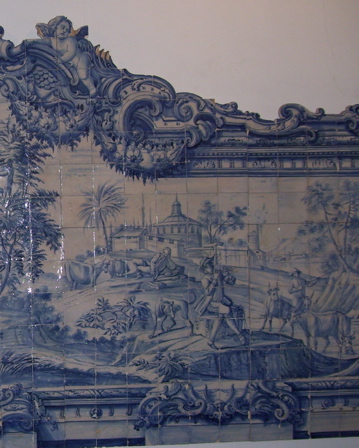
 The map shows the route of our cruise. We flew
to London on August 7 (our 42nd anniversary day), arriving at
Heathrow on the 8th. We embarked on the 9th from Dover, around
4:00 PM in stormy weather.
The map shows the route of our cruise. We flew
to London on August 7 (our 42nd anniversary day), arriving at
Heathrow on the 8th. We embarked on the 9th from Dover, around
4:00 PM in stormy weather.  Oporto
is known for its port wines, and we visited a winery for a
tasting. We had our first taste of exotic Moorish architecture
while visiting the Palácio
da Bolsa (Classical Stock Exchange).
The tour took us from room to room, pointing out the beautiful
inlaid wood work, geometric patterns and different exotic woods
(some naturally red in color, others black) from Africa and the New
World to demonstrate the wealth accumulated by Portugal at that
time. Then we went into the The Arabian Room and were blown
away by the colors and intricate designs as shown in Lois' picture
at right. Click here for Internet view of the entire Arabian
Room. For several hundred years, Jews, Moors and
Christians peacefully co-existed throughout the Iberian Peninsula,
in both Spain and Portugal, and they each played an important role
in the commerce of the area.
Oporto
is known for its port wines, and we visited a winery for a
tasting. We had our first taste of exotic Moorish architecture
while visiting the Palácio
da Bolsa (Classical Stock Exchange).
The tour took us from room to room, pointing out the beautiful
inlaid wood work, geometric patterns and different exotic woods
(some naturally red in color, others black) from Africa and the New
World to demonstrate the wealth accumulated by Portugal at that
time. Then we went into the The Arabian Room and were blown
away by the colors and intricate designs as shown in Lois' picture
at right. Click here for Internet view of the entire Arabian
Room. For several hundred years, Jews, Moors and
Christians peacefully co-existed throughout the Iberian Peninsula,
in both Spain and Portugal, and they each played an important role
in the commerce of the area. 



 We
took a two hour drive through the foothills to the base of the
Sierra Nevada, into the region known as Granada, and up to the
Alhambra Palace. As we drove the landscape looked very much
like Southern Cal, with hillsides of brown dried out grasses and a
smattering of trees. Our road transversed a major
agricultural area, with olive and avocado groves. We saw only
minimal livestock. We went through the city of Granada, and
then up a steep windy road to reach the Alhambra, where we were
transported back in time to buildings out of the Arabian
Nights. The Alhambra was a palace and fortress complex of the
Moorish rulers of Granada in southern Spain, dating from around
1235. When Ferdinand and Isabella conquered the Moors in 1492,
they wanted to make the Alhambra their capital given that it was
considered one of the most beautiful buildings in all of
Spain. But after their deaths in the early 1500's the capital
moved to Madrid and the Alhambra went into disrepair. It was
the American writer Washington Irving, whose travel guide Tales of the Alhambra, first
published in 1850, brought this incredible architectural gem to the
attention of the world. The Alhambra is considered one of the
greatest accomplishments of Islamic art and architecture. The
horseshoe archways, the intricate and rich designs, the quiet
fountains and lovely gardens were truly
awesome. We saw the remnants of colored
tiles, decorative motifs including arcades, pools, fountains in a
spectacular garden, and inner courtyards, vistas and rooms with
intricate niches, ceilings and vaults. We were told that the
Arabian Room at the Oporto Stock Exchange was illustrative of what
the interior of the entire Alhambra would have been. We ended
our visit seeking out a gift shop to purchase both a copy of
Washington Irving's Tales
and tee-shirts.
We
took a two hour drive through the foothills to the base of the
Sierra Nevada, into the region known as Granada, and up to the
Alhambra Palace. As we drove the landscape looked very much
like Southern Cal, with hillsides of brown dried out grasses and a
smattering of trees. Our road transversed a major
agricultural area, with olive and avocado groves. We saw only
minimal livestock. We went through the city of Granada, and
then up a steep windy road to reach the Alhambra, where we were
transported back in time to buildings out of the Arabian
Nights. The Alhambra was a palace and fortress complex of the
Moorish rulers of Granada in southern Spain, dating from around
1235. When Ferdinand and Isabella conquered the Moors in 1492,
they wanted to make the Alhambra their capital given that it was
considered one of the most beautiful buildings in all of
Spain. But after their deaths in the early 1500's the capital
moved to Madrid and the Alhambra went into disrepair. It was
the American writer Washington Irving, whose travel guide Tales of the Alhambra, first
published in 1850, brought this incredible architectural gem to the
attention of the world. The Alhambra is considered one of the
greatest accomplishments of Islamic art and architecture. The
horseshoe archways, the intricate and rich designs, the quiet
fountains and lovely gardens were truly
awesome. We saw the remnants of colored
tiles, decorative motifs including arcades, pools, fountains in a
spectacular garden, and inner courtyards, vistas and rooms with
intricate niches, ceilings and vaults. We were told that the
Arabian Room at the Oporto Stock Exchange was illustrative of what
the interior of the entire Alhambra would have been. We ended
our visit seeking out a gift shop to purchase both a copy of
Washington Irving's Tales
and tee-shirts.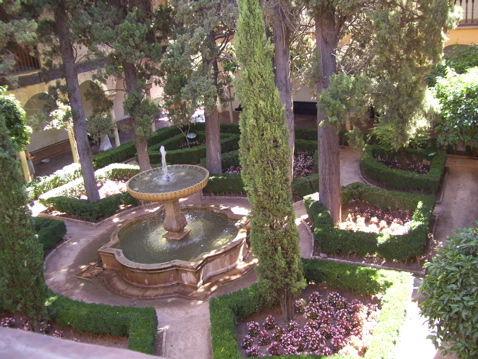
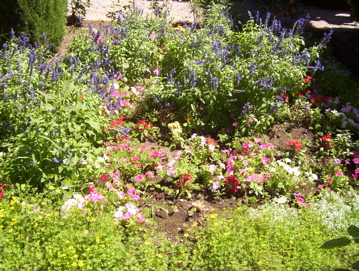
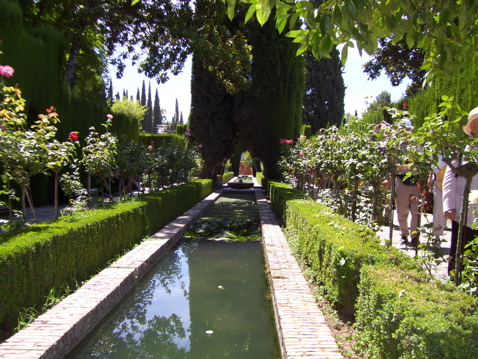

 trading houses with their beautiful mosaics, are
well preserved, as are the sewer and fresh water canals. The
Roman government’s position was at the time to provide free food and
entertainment to keep the populace happy and content (i.e.,
preventing uprisings and rioting).
trading houses with their beautiful mosaics, are
well preserved, as are the sewer and fresh water canals. The
Roman government’s position was at the time to provide free food and
entertainment to keep the populace happy and content (i.e.,
preventing uprisings and rioting).
